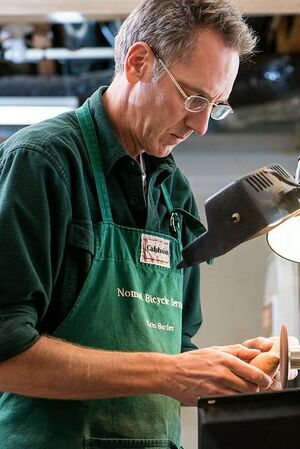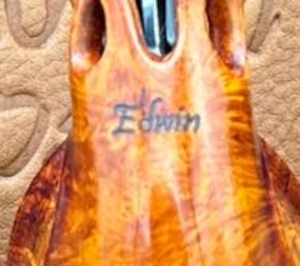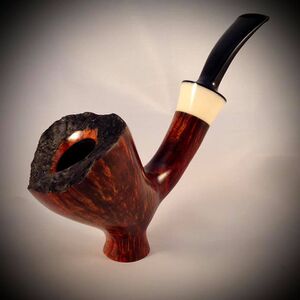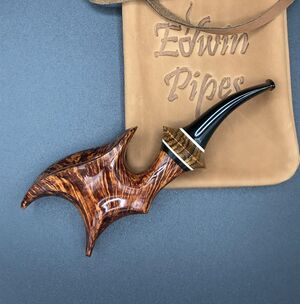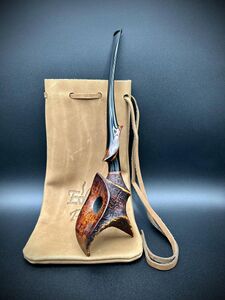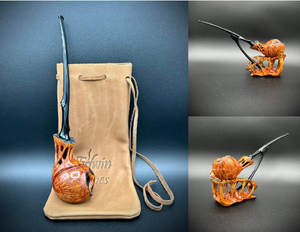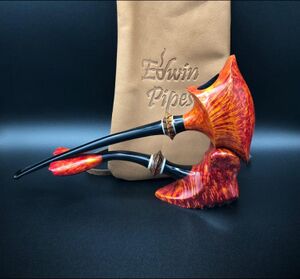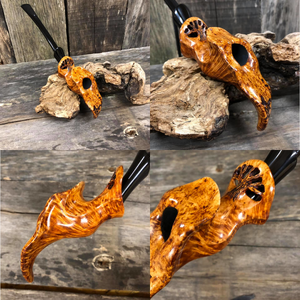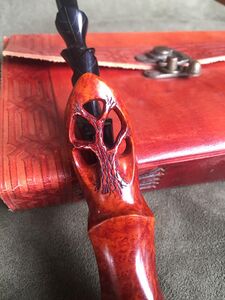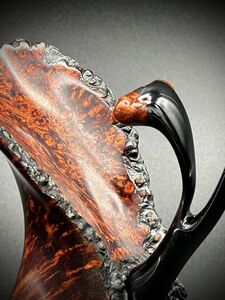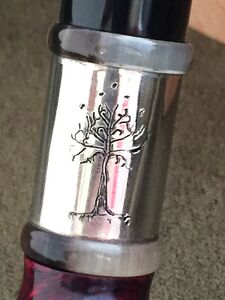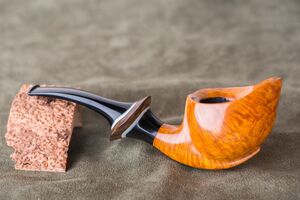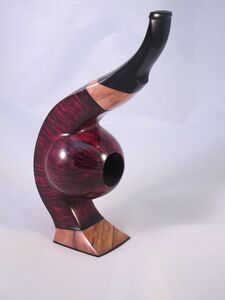Edwin Pipes: Difference between revisions
(Created page with "From the Edwin Pipes [http://edwinpipes.com/ Website] Twenty years ago I was living in the Bavarian Alps where pipe smoking is much more popular than here in the U.S. I rememb...") |
mNo edit summary |
||
| (10 intermediate revisions by 2 users not shown) | |||
| Line 1: | Line 1: | ||
[[File:Edwin profile.jpg|thumb|Kris Edwin Barber.]] | |||
[[File:Edwin stamp.png|thumb|Edwin Pipes stamp / nomenclature.]] | |||
Edwin Pipes are made by Kris Edwin Barber, an artisan pipe-maker based n Northern Minnesota in the United States. | |||
Barber's first significant encounter with tobacco pipes came when he was living in the Bavarian Alps in Germany. Barber was captivated by the smoke emanating from the pipe of a stranger who happened to pass by, leaving Barber with the desire to be surrounded by such smells. As Barber noted on a previous version of his website,<blockquote>The aroma was wonderful; kind of a woody campfire note mixed with a subtle cherry flavor. I remember thinking how pleasant it would be to have that fragrance surrounding me all the time so the very next day I borrowed a pipe from a friend, poured a generous amount of his dry tobacco into the bowl, struck a match, and…I hated it. </blockquote> | |||
[[File:Edwin 2023.jpg|left|thumb|Barber's current pipe making leans heavily into the churchwarden design, while also incorporating a distinct approach to freehand shaping. Unconventional staining hues are also a common feature in Edwin pipes, as are stands, which are often created from the same briar block as the pipe itself. Image courtesy Kris Edwin Barber]] | |||
This is hardly an uncommon experience for new pipe smokers. Barber was undeterred, however, and would later note - again, on the older version of his website - that the quality of the pipe itself has a significant impact on the quality of the smoking experience. | |||
Barber did not immediately begin making pipes. In 2010, his research into tobacco pipes on the Internet allowed him to discover the world of high-grade artisan pipes, leading Barber to become fascinated with the sheer 'artistry' involved in creating such an artifact. This fascination first led him to undertake pipe refurbishing; purchasing inexpensive, fatigued estate pipe lots, restoring them, and them selling them on allowed Barber to develop his practical and aesthetic understanding of pipes and helped finance the equipment necessary to create them. This would be the end of Barber's refurbishing career - and the birth of his career as a pipe maker. As his current (2023) website states:<blockquote>After two years and hundreds of refurbs, the time had come. I sat on a fully-stocked workshop and a head full of knowledge. On a whim I bought a block of briar and made my first pipe. The joy of creating took me and suddenly I had this new outlet for my own artistry. I never refurbed another.</blockquote>In terms of influences, Barber was initially attracted to the younger generation of American artisans who came to prominence in the 21st century, such as [[J. Alan Pipes|Jeff 'J. Alan' Gracik]], [[Adam Remington]], [[G. Batson Pipes|Grant Batson]], [[Armentrout|Nathan Armentrout]], [[Tyler Lane Pipes|Tyler Lane Beard]], and others. Poring over the websites of these artisans, Barber would occasionally come across a pipe that was particularly captivating, which he would then use as a model for his own interpretation of its design. | |||
[[File:Edwin Standing dublin.jpg|thumb|An early Edwin pipe, modeled after the standing or dancing Dublin shape of makers such as J. Alan. Image courtesy Kris Edwin Barber.]] | |||
Having been involved in carpentry from a young age, Barber found that working with briar came fairly naturally. Ebonite was different - this required Barber to learn to use a new material from scratch. In time, Barber became acquainted with this popular pipe-making resin, which became a staple material for his stems. | |||
After 6 years of making pipes part time, Barber was able to take up making Edwin pipes as his full time profession in 2018. At the same time, he moved his workshop to the shores of Lake Superior, in North-East Minnesota. <br>Contemporary Edwin pipes are marked by a distinct approach to form. While they might most readily be classified as 'freehands', Barber appears to eschew the rugged, aleatory stylings of the freehands offered, for example, by makers such as [[Nørding]]. While Barber has professed a fondness for the Danish tradition in hand made pipes, his own work does not fit neatly into the popular neo-Danish design philosophies of most current artisans either. Part of this is due to Barber's strong focus on churchwarden-style pipes, or at least pipes that are churchwarden length, which is very rare in the current artisan scene. Another rare property of Barber's work is the creation of elaborate stands for his pipes, especially his churchwardens, which is similarly rare today, but was somewhat more common in 20th century American and Danish freehand carving, such as in the works of [[Michael Kabik]] or [[Åge Bogelund]]. | |||
Neither Barber's pipes nor his stands resemble Kabik's or Bogelund's, however - though his frequent use of split stems does recall the latter's. This is because the most distinct aspect of an Edwin Pipe is an aesthetic character that oscillates between formal extremities; between hard and soft, sharp and smooth, solid and liquid, and so on. Like the higher-end pipes produced by [[Holm, Preben|Preben Holm]], Barber's pipes are a strange marriage of the stone and the flower. There are lines in an Edwin Pipe that flow seamlessly from lips and edges so jagged they recall debris from a landslide, to the efflorescent curls and swells. That the figure of the 'dragon' is a recurring theme in Barber's work is not surprising; not simply because of its association with fantasy literature (of which Barber is a fan) and the pipes that have frequently also been part of these worlds, but because the mythical dragon is a creature whose appearance juxtaposes forms of organic life with instruments of death. | |||
While the designs of Edwin pipes frequently incorporate unsettling elements, which in addition to those described include semblances of flesh, decay, mold and mycelium, scalding wax, as well as figures more at home in an H.R. Giger painting, Barber's work does not hitch itself to shock value. Rather, it seems more like Barber is simply exploring what briar and ebonite can do. In his own descriptions of Edwin pipes, Barber emphasizes a commitment to genuine artistry in these pursuits. While Edwin pipes are undoubtedly beautiful, they also demonstrate that good art is rarely a matter of beauty alone. | |||
[[File:Edwin short dragon.jpg|left|thumb|'Short Dragon' by Edwin Pipes, made in 2021. This pipe incorporates another common feature in current Edwin pipes, that being split stems with inserts of briar or other materials. Image courtesy Kris Edwin Barber.]] | |||
Kris | You might also like to listen to Brian Levine's interview with Kris on the [http://pipesmagazine.com/blog/radio-talk-show/the-pipes-magazine-radio-show-episode-41/#more-7017 Pipes Magazine Radio Show]. | ||
<br clear=all> | |||
== Gallery == | |||
<gallery widths="300" heights="300" perrow="3"> | |||
File:Edwin blast churchwarden.jpg|A rare, partially sandblasted Edwin pipe, made in 2023. | |||
File:Edwin Ball Composite.png|A ball shaped Edwin pipe, made in 2023. | |||
File:Edwin 2021.jpg|One of Barber's 'Elephants Shield' series of Edwin Pipes. | |||
File:Edwin 2019 drip.png|An Edwin pipe made in 2019 invokes melting wax, albeit in a more extreme manner than is found in Italian brands such as Caminetto or Ser Jacopo. | |||
File:Edwin tree.jpg|The tree is a frequent motif in Edwin pipes. | |||
File:Stand detail.jpg|Close up of an Edwin Pipes stand. | |||
File:Edwin LOTR churchwarden 2 1.jpg|Silverwork on an Edwin pipe. | |||
File:Edwin 2016.jpg|An earlier Edwin pipe, made in 2016, shows the beginnings of his current style, especially in the stem work, | |||
File:Edwin 2015 2.jpg|An Edwin pipe from 2015, perhaps one inspired by [[Tokutomi, Hiroyuki|Tokutomi]]. | |||
</gallery> | |||
== Contact Information == | |||
Kris Edwin Barber | Kris Edwin Barber | ||
Website: http://edwinpipes.com/ | Website: http://edwinpipes.com/ | ||
Facebook: https://www.facebook.com/EdwinPipes/ | |||
Instagram: https://www.instagram.com/edwinpipes/?hl=en | |||
E-mail: edwinpipes@yahoo.com | E-mail: edwinpipes@yahoo.com | ||
Phone: 952-356-9299. | Phone: 952-356-9299. | ||
[[Category: Pipe makers by nationality]][[Category: United States]] | [[Category: Pipe makers by nationality]][[Category: United States]] | ||
Latest revision as of 20:51, 2 January 2024
Edwin Pipes are made by Kris Edwin Barber, an artisan pipe-maker based n Northern Minnesota in the United States.
Barber's first significant encounter with tobacco pipes came when he was living in the Bavarian Alps in Germany. Barber was captivated by the smoke emanating from the pipe of a stranger who happened to pass by, leaving Barber with the desire to be surrounded by such smells. As Barber noted on a previous version of his website,
The aroma was wonderful; kind of a woody campfire note mixed with a subtle cherry flavor. I remember thinking how pleasant it would be to have that fragrance surrounding me all the time so the very next day I borrowed a pipe from a friend, poured a generous amount of his dry tobacco into the bowl, struck a match, and…I hated it.
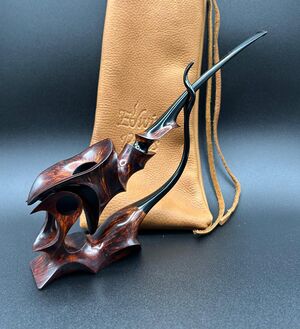
This is hardly an uncommon experience for new pipe smokers. Barber was undeterred, however, and would later note - again, on the older version of his website - that the quality of the pipe itself has a significant impact on the quality of the smoking experience.
Barber did not immediately begin making pipes. In 2010, his research into tobacco pipes on the Internet allowed him to discover the world of high-grade artisan pipes, leading Barber to become fascinated with the sheer 'artistry' involved in creating such an artifact. This fascination first led him to undertake pipe refurbishing; purchasing inexpensive, fatigued estate pipe lots, restoring them, and them selling them on allowed Barber to develop his practical and aesthetic understanding of pipes and helped finance the equipment necessary to create them. This would be the end of Barber's refurbishing career - and the birth of his career as a pipe maker. As his current (2023) website states:
After two years and hundreds of refurbs, the time had come. I sat on a fully-stocked workshop and a head full of knowledge. On a whim I bought a block of briar and made my first pipe. The joy of creating took me and suddenly I had this new outlet for my own artistry. I never refurbed another.
In terms of influences, Barber was initially attracted to the younger generation of American artisans who came to prominence in the 21st century, such as Jeff 'J. Alan' Gracik, Adam Remington, Grant Batson, Nathan Armentrout, Tyler Lane Beard, and others. Poring over the websites of these artisans, Barber would occasionally come across a pipe that was particularly captivating, which he would then use as a model for his own interpretation of its design.
Having been involved in carpentry from a young age, Barber found that working with briar came fairly naturally. Ebonite was different - this required Barber to learn to use a new material from scratch. In time, Barber became acquainted with this popular pipe-making resin, which became a staple material for his stems.
After 6 years of making pipes part time, Barber was able to take up making Edwin pipes as his full time profession in 2018. At the same time, he moved his workshop to the shores of Lake Superior, in North-East Minnesota.
Contemporary Edwin pipes are marked by a distinct approach to form. While they might most readily be classified as 'freehands', Barber appears to eschew the rugged, aleatory stylings of the freehands offered, for example, by makers such as Nørding. While Barber has professed a fondness for the Danish tradition in hand made pipes, his own work does not fit neatly into the popular neo-Danish design philosophies of most current artisans either. Part of this is due to Barber's strong focus on churchwarden-style pipes, or at least pipes that are churchwarden length, which is very rare in the current artisan scene. Another rare property of Barber's work is the creation of elaborate stands for his pipes, especially his churchwardens, which is similarly rare today, but was somewhat more common in 20th century American and Danish freehand carving, such as in the works of Michael Kabik or Åge Bogelund.
Neither Barber's pipes nor his stands resemble Kabik's or Bogelund's, however - though his frequent use of split stems does recall the latter's. This is because the most distinct aspect of an Edwin Pipe is an aesthetic character that oscillates between formal extremities; between hard and soft, sharp and smooth, solid and liquid, and so on. Like the higher-end pipes produced by Preben Holm, Barber's pipes are a strange marriage of the stone and the flower. There are lines in an Edwin Pipe that flow seamlessly from lips and edges so jagged they recall debris from a landslide, to the efflorescent curls and swells. That the figure of the 'dragon' is a recurring theme in Barber's work is not surprising; not simply because of its association with fantasy literature (of which Barber is a fan) and the pipes that have frequently also been part of these worlds, but because the mythical dragon is a creature whose appearance juxtaposes forms of organic life with instruments of death.
While the designs of Edwin pipes frequently incorporate unsettling elements, which in addition to those described include semblances of flesh, decay, mold and mycelium, scalding wax, as well as figures more at home in an H.R. Giger painting, Barber's work does not hitch itself to shock value. Rather, it seems more like Barber is simply exploring what briar and ebonite can do. In his own descriptions of Edwin pipes, Barber emphasizes a commitment to genuine artistry in these pursuits. While Edwin pipes are undoubtedly beautiful, they also demonstrate that good art is rarely a matter of beauty alone.
You might also like to listen to Brian Levine's interview with Kris on the Pipes Magazine Radio Show.
Gallery
An Edwin pipe from 2015, perhaps one inspired by Tokutomi.
Contact Information
Kris Edwin Barber Website: http://edwinpipes.com/ Facebook: https://www.facebook.com/EdwinPipes/ Instagram: https://www.instagram.com/edwinpipes/?hl=en E-mail: edwinpipes@yahoo.com Phone: 952-356-9299.
